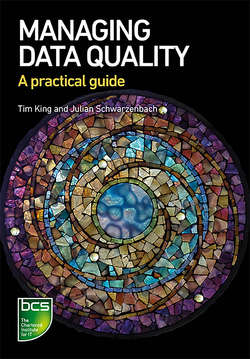Читать книгу Managing Data Quality - Tim King - Страница 16
На сайте Литреса книга снята с продажи.
Оглавлениеxvi
legal or reputational. These risks and issues could be significant. Standing still is almost certainly not a viable option.
From the perspective of the enterprise as a whole, therefore, managing data quality effectively can be such a large task that it either never gets started or is viewed as so expensive that it eats up budget that could be better used elsewhere.
This book will help you to overcome this perceived complexity with practical solutions, by understanding:
the nature of the data asset and why it can be difficult to manage;
the impact of people and behaviours on data quality;
the ISO 8000-61 framework and how it defines approaches to data quality management;
how to develop strategies for change that are relevant to your organisation.
Data and changing technology
Over the many years since computing first became a commercial activity, there have been numerous changes in technology. At the highest level has been the progression from mainframes to personal computers, client/server systems, network computers, cloud computing, the Internet of Things (IoT) and big data analytics. Within each of these broad categories, technologies and approaches have continually evolved. Each evolutionary step is often sold on the basis of overcoming the shortcomings of the previous technology. Today’s latest technology, likewise, will be replaced in the future as new user requirements are discovered and improved technological approaches are developed.
Throughout all these changes in technology, data should have been a constant factor. They should have been migrated without loss of meaning from the old technology to the new, so as to sustain the effective delivery of organisational outcomes. However, data migration projects have historically been high risk and likely to fail in terms of time, cost or quality. For example, data can be lost or corrupted as part of the migration process, with such problems possibly affecting significant volumes of data. Similarly, changing data requirements over time can mean that older data structures are no longer fully understood, resulting in corruption during migration. Data migration approaches, such as the one defined by Johny Morris in his book Practical Data Migration 3rd edn. (2020), help organisations to maximise the chances of successful data migration.
For many organisations, the entities that data represent have existed through multiple data stores and software systems; for example:
an individual born in 1950 will have had their personal details, careers, financial records and so on, stored in multiple systems over the course of their lives;
infrastructure assets such as railways, bridges and buildings can be more than 100 years old (with an expectation that they will continue to provide useful service
PREFACE
